 |
| Midg Falling Plate Camera with Ilford Selochrome glass plate |
To mark one hundred years since the first photographs that became known as the
Cottingley Fairies were taken, I decided to use last weekend's '
Take Your Box Camera To Play Day' to make a homage to the young photographers of this hoax. A counterpart to '
Take Your Box Camera To Work Day', I had been thinking of using the
Midg falling plate camera for this event; as Elsie Wright and Frances Griffiths used a Midg camera for their first set of photographs, this appeared to be a fitting subject to shoot on the day. For the fairies, I went back to the source material that the girls had used for their first published photograph, known as 'Frances and the Fairies', figures taken from an illustration in
Princess Mary's Gift Book, as pointed out by the debunker James Randi. I shot the scene at the bottom of the garden on glass plates, as would have originally been used in the Midg. I didn't have any glass plates from 1917; I used some Ilford Selochrome plates from a box which had a label inside dated to February 1945 (as a footnote to this date, the paper that the box was wrapped in had a cheaper, coarser feel than the more usual brown paper that Ilford used for wrapping plate boxes until the end of the 1950s, which might reflect on wartime paper shortages).
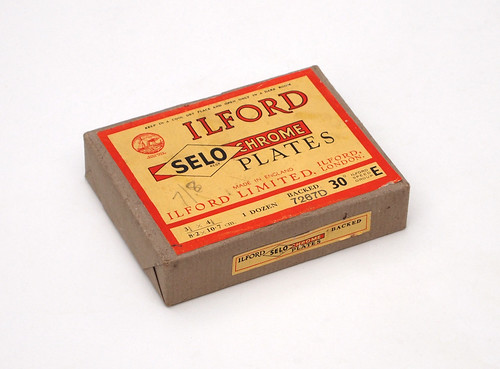 |
| Ilford Selochrome plates |
I had problems with the first set of glass plates that I shot not falling down cleanly inside the camera when released; some of these, such as the image below, fell flat against the inside of the front of the camera, and the large white circle on the right hand side is from the plate being exposed directly behind the lens. Other plates then had the shadow of the plates stuck at the front of the camera partially obscuring the projected image during exposure. It was also clear that the focus distance wasn't very accurate; when I had used the camera before I had discovered that the 3 feet setting was actually more like 4 feet: the image at the top of the post was much closer to this distance (as was the last shot on FP4 film at the bottom of this post). After developing the first set of glass plates, I then shot another set, with more success, but I did still have problems with the plates not falling down inside the camera as they should, anticipating that, I was able to open the camera in a black bag and manually place the exposed plates flat at the bottom of the camera. When writing about the Midg, I had used a quote describing how the mechanism would jam at critical moments; this seemed to be one such moment.
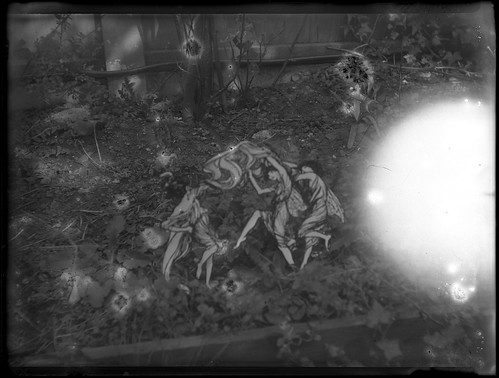 |
| Midg Falling Plate Camera with Ilford Selochrome glass plate |
As well as the Selochrome plates, I also shot some
Ilford G.30 Chromatic plates from the mid-1960s. I'd used a number of these plates over the past few years, mostly with a fair amount of success. The plates from this current box suffer from a large amount of fogging around the edges, something I've experienced with some glass plates. I rated these at 10 as well, but with the light fading in the late afternoon to early evening when I took a second set of photographs, the photographs probably needed more exposure then I gave them to mitigate the fogging; the lighting had been better earlier in the day: in the image above, softer light integrates the cut out into its surroundings better. Had I taken more time over the photographs, I would have also painted in the cut out figures to provide a better tonal range.
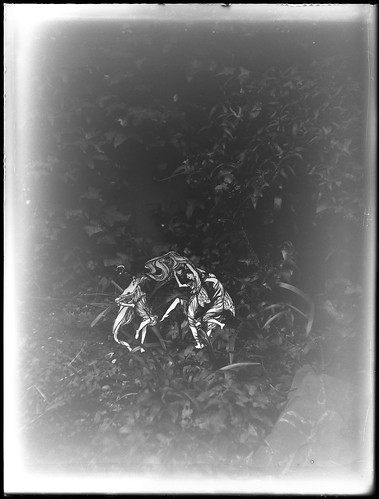 |
| Midg Falling Plate Camera with Ilford G.30 Chromatic glass plate |
I also shot a magazine's worth of Ilford FP4 film, from a box with a handwritten date of 16/11/78 (a leaflet inside the box dates to December 1977). None of these photographs suffered from the mechanism failing, which might reflect using the camera in the hand, rather than the fairy photographs, for which I used a tripod, and had to tip up the camera while still on the tripod to tilt it forward to get the plates to fall. When I'd used the Midg previously, I had shot some FP3 film, dating back to around 1950, and rated it with an exposure index of around 12; with the more recent FP4, I wanted to use the Midg hand-held. One of the problems with the Midg is that its shutter only fires at one speed, as the adjustment mechanism does not appear to change the 'instant' setting at all. The shutter fires around 1/50th, so I shot all the film with the lens wide open at f8; lighting conditions were fairly overcast, so I gave the film a one-and-a-half stop push in development (although a couple of sheets were stand developed with the plates). Some of the negatives were very thin, but the results from most of the shots were surprisingly good, and an instructive comparison to many of the photographs taken
two years ago when I first wrote about the Midg.
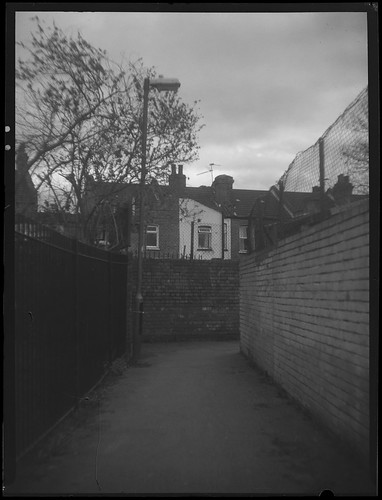 |
| Midg Falling Plate Camera with Ilford FP4 film |
 |
| Midg Falling Plate Camera with Ilford FP4 film |
 |
| Midg Falling Plate Camera with Ilford FP4 film |
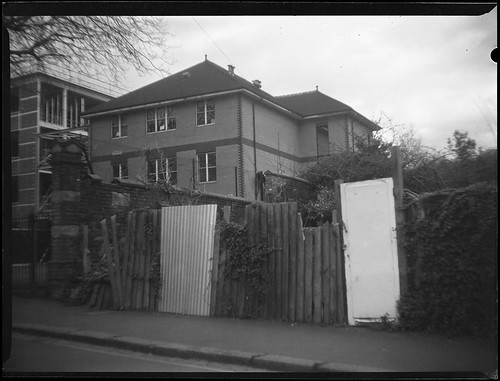 |
| Midg Falling Plate Camera with Ilford FP4 film |
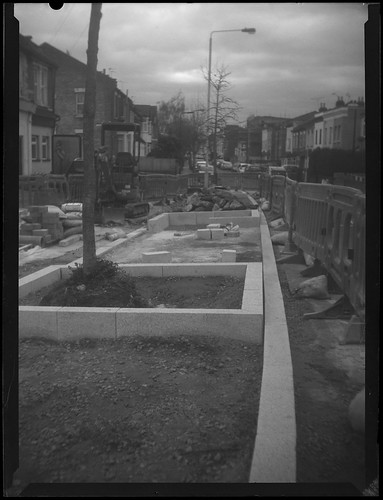 |
| Midg Falling Plate Camera with Ilford FP4 film |
 |
| Midg Falling Plate Camera with Ilford FP4 film |










No comments:
Post a Comment